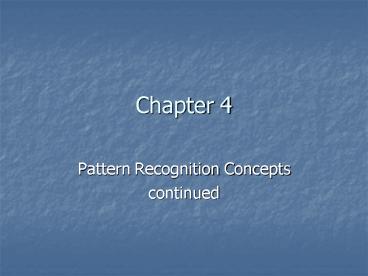Pattern Recognition Concepts - PowerPoint PPT Presentation
1 / 37
Title:
Pattern Recognition Concepts
Description:
Chapter 4. Pattern Recognition Concepts. continued. Using ... Structural (pattern recognition) techniques. Simple features may not be enough for recognition. ... – PowerPoint PPT presentation
Number of Views:178
Avg rating:3.0/5.0
Title: Pattern Recognition Concepts
1
Chapter 4
- Pattern Recognition Concepts
- continued
2
Using features
- Ex. Recognizing characters
- Area
- Height
- Width
- of holes
- of strokes
- Centroid
- Best axis (of least inertia)
- Second moments (about axis of least and most
inertia)
3
Decision tree
4
(No Transcript)
5
(No Transcript)
6
Classifying using nearest class mean
- Some problems are more fuzzy and cant be
solved using simple decision trees. - To classify an candidate, c, compute its distance
from all know class means and assign it to the
same class as the class of the nearest mean.
7
Classifying using nearest class mean (with good
results)
8
Euclidean distance (and scaled Euclidean distance)
9
Classifying using nearest class mean (with poor
results)
10
Classifying using nearest neighbor
- To classify an candidate, c, compute its distance
to all member of all know classes and assign it
to the same class as the class of the nearest
element.
11
(No Transcript)
12
Precision vs. recall
- Say we have an image db we wish to query.
- Show me all images of tanks.
- Precision of relevant documents retrieved
divided by the total number of documents
retrieved - Precision TP / (TPFP)
- PPV positive predictive value
- Probability that the target is is actually
present when the observer says that is it
present.
13
Precision vs. recall
- Say we have an image db we wish to query.
- Show me all images of tanks.
- Recall of relevant documents retrieved
divided by the total number of relevant documents
in the db. - Recall TP / (TPFN) TPF
- Negative predictive value
- NPV TN / (TNFN)
- Probability that the target is actually absent
when the observer says that it is absent.
14
Structural (pattern recognition) techniques
- Simple features may not be enough for
recognition. - So relationships between these primitive features
are used (in structural techniques).
15
- Same bounding box, holes, strokes, centroid, 2nd
moments in row and column directions, and similar
major axis direction.
16
bayintrusion of background
17
bayintrusion of background
lidvirtual line segment that close the bay
18
Structural graph
- G(V,E)
- where is a vertex set and E is an edge set
- V
- S side
- L lake
- B bay
- E
- CON connection of 2 strokes
- ADJ stroke region is immediately adjacent to a
lake or bay region - ABOVE 1 hole (lake or bay) lies above another
19
(No Transcript)
20
Structural conclusions
- Graph-matching techniques can be used for
recognition. - Or we can count occurrences of relationships and
use these counts as a feature vector for
statistical PR.
21
Confusion matrix
22
- Empirical error rate misclassified
- Empirical reject rate rejected
23
- Empirical error rate misclassified 25/1000
overall (does not include rejects) 5/100 for 9s - Empirical reject rate rejected 7/1000
- Can ROC analysis be applied?
24
- Recall ROC analysis
- TP true positive present and detected
- TN true negative not present and not detected
- FP false positive not present but detected
- FN false negative present but not detected
- True positive fraction
- TPF TP / (TPFN)
- true abnormals called abnormal by the observer
- False positive fraction
- FPF FP / (FPTN)
25
- Ex. ROC analysis for the classification of 3
- TP present and detected
- TN not present and not detected
- FP not present but detected
- FN present but not detected
26
Skip remainder of Chapter 4
27
(No Transcript)
28
(No Transcript)
29
(No Transcript)
30
(No Transcript)
31
(No Transcript)
32
(No Transcript)
33
(No Transcript)
34
(No Transcript)
35
(No Transcript)
36
(No Transcript)
37
(No Transcript)































